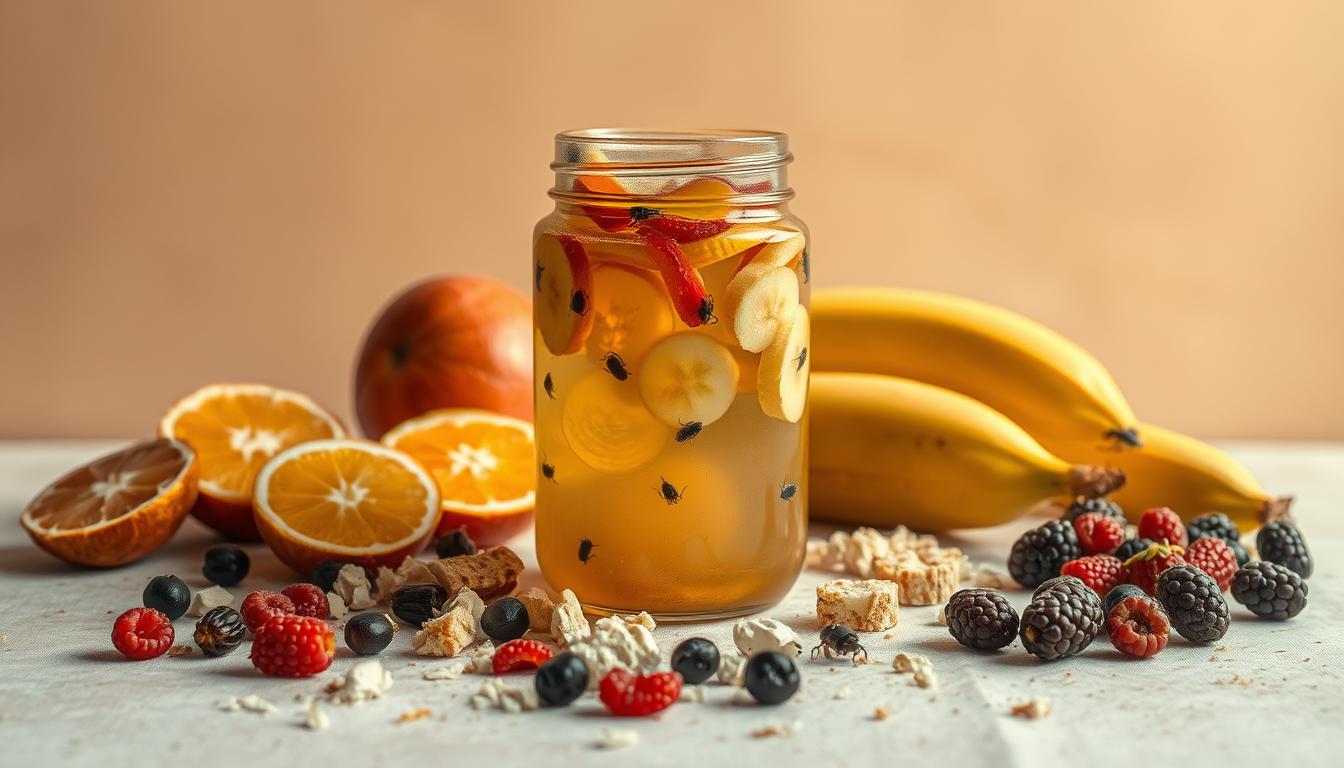As temperatures rise, unwanted guests start to appear in our homes. DIY Fruit Fly Trap Pesky insects hovering around ripe produce and fermenting liquids can quickly become a source of frustration.
A simple and effective solution to this problem is creating a homemade trap. By using common household items, you can easily capture and eliminate these nuisance insects.
Creating a DIY trap is not only cost-effective but also a fun and easy project. With a few simple ingredients, you can say goodbye to those annoying insects.
Key Takeaways
- Homemade traps are an effective solution to the fruit fly problem.
- Creating a DIY trap is easy and cost-effective.
- Common household items can be used to capture and eliminate fruit flies.
- A DIY trap is a simple and efficient way to deal with nuisance insects.
- With a few simple ingredients, you can create a trap that works.
Why Fruit Flies Invade Your Home
If you’re wondering why your home is suddenly infested with fruit flies, you’re not alone. Fruit flies are attracted to ripe or fermenting fruits and vegetables, and their presence is often a sign of something amiss in your kitchen.
The Life Cycle of Fruit Flies
Fruit flies, scientifically known as Drosophila melanogaster, have a short life cycle that enables them to multiply quickly. They begin as eggs, typically laid near their food source, and hatch into larvae within a day. The larvae feed on the surrounding material before pupating and emerging as adult flies.
Common Causes of Fruit Fly Infestations
Several factors contribute to fruit fly infestations. Overripe or rotting fruit, vegetables, and fermenting substances are common attractants. Additionally, clogged drains, garbage disposals, and trash cans can harbor fruit fly eggs and larvae. To prevent infestations, it’s essential to maintain a clean kitchen, dispose of waste properly, and eliminate standing water.
The Science Behind Effective Fruit Fly Traps
To comprehend how fruit fly traps work, it’s essential to understand what attracts these insects in the first place. Fruit flies are drawn to fermenting or ripe substances, which is why they often infest kitchens and areas where food is prepared or disposed of.
What Attracts Fruit Flies
Fruit flies are attracted to a variety of substances, including:
- Fermenting fruits and vegetables
- Alcoholic beverages
- Sugary substances
- Vinegar and other acidic liquids
These attractants are often used in fruit fly traps to lure the flies in.
How Traps Work to Capture Them
Fruit fly traps typically work by using a combination of attractants and a trapping mechanism. The attractant lures the flies into the trap, while the trapping mechanism prevents them from escaping. Common trapping mechanisms include:
- Funnel traps that guide flies into a container from which they cannot escape
- Sticky surfaces coated with a adhesive that traps flies
- Drowning solutions where flies are attracted to a liquid and then drown
By understanding the science behind fruit fly attractants and trapping mechanisms, you can create effective DIY traps to eliminate fruit flies from your home.
Essential Materials for Fruit Fly Trap DIY Projects
Creating a DIY fruit fly trap requires some basic household items that you likely already have on hand. The beauty of these traps is their simplicity and the fact that they utilize items you might otherwise discard or think useless.
Common Household Items You’ll Need
Most fruit fly traps can be made using common household items. These include:
- Apple cider vinegar or white vinegar
- Dish soap
- Plastic bottles or jars
- Plastic wrap
- A small piece of cloth or paper
- A rubber band
Optional Ingredients for Enhanced Effectiveness
While the basic ingredients can effectively trap fruit flies, there are some optional ingredients you can use to enhance the trap’s effectiveness:
- Essential oils like lemon or lavender
- Fruit juice or wine
- Bananas or other ripe fruits
These ingredients can be used to create a more attractive bait for the fruit flies, increasing the trap’s effectiveness.
Shopping List for Multiple Trap Types
If you decide to try out multiple trap types or want to have a запас (backup) plan, here’s a combined shopping list:
| Item | Quantity | Usage |
| Vinegar | 1 cup | Bait for fruit flies |
| Dish soap | 1-2 teaspoons | Breaks surface tension |
| Plastic bottles | 2-3 | Trap container |
| Plastic wrap | 1 roll | Covers the trap |
By having these materials on hand, you can experiment with different trap variations to find what works best for you.
Classic Vinegar and Dish Soap Fruit Fly Trap
The classic vinegar and dish soap fruit fly trap is a tried-and-true method for capturing those pesky flies that invade your kitchen. This simple, effective solution utilizes common household items to create a trap that can significantly reduce fruit fly populations.
Materials Needed
To create this effective trap, you’ll need the following materials:
- Apple cider vinegar
- Dish soap
- A small bowl or container
- Plastic wrap
Step-by-Step Instructions
Follow these simple steps to create your vinegar and dish soap fruit fly trap:
- Pour about an inch of apple cider vinegar into the bowl.
- Add a few drops of dish soap to the vinegar.
- Cover the bowl with plastic wrap, securing it with a rubber band if necessary.
- Poke a few small holes in the plastic wrap to allow the fruit flies to enter.
Why This Trap Works So Well
The combination of apple cider vinegar and dish soap is highly effective because the vinegar attracts fruit flies with its fermented smell, while the dish soap breaks the surface tension of the liquid. This causes the flies to sink and become trapped when they land on the surface. The plastic wrap cover ensures that the flies can’t simply fly away, making this a highly effective trap for eliminating fruit flies in your home.
By using this classic vinegar and dish soap fruit fly trap, you can enjoy a fruit fly-free kitchen without resorting to harsh chemicals or expensive commercial traps.
Apple Cider Vinegar Trap Variations
Apple cider vinegar’s potency in capturing fruit flies has led to various trap adaptations. The basic principle remains the same: attract fruit flies with the vinegar’s strong aroma and trap them using a trapping mechanism.
Basic Apple Cider Vinegar Trap
The simplest form of this trap involves mixing apple cider vinegar with dish soap in a jar. The soap breaks the surface tension, causing the flies to sink when they land on the liquid. This method is effective because it directly addresses the flies’ attraction to the vinegar’s smell.
Enhanced Apple Cider Vinegar Solutions
To enhance the trap’s effectiveness, some variations include adding a few drops of essential oils known to attract fruit flies or using a funnel to direct the flies into the trap, making it harder for them to escape.
Troubleshooting Common Issues
If the trap isn’t working as expected, check that the apple cider vinegar is ripe and pungent. Also, ensure the dish soap is properly mixed with the vinegar. Adjusting the proportions or replacing the mixture can significantly improve the trap’s performance.
By experimenting with these variations, you can find the most effective apple cider vinegar trap for your needs.
Wine-Based Fruit Fly Traps
Wine, especially red wine, has been found to be a potent lure for fruit flies, making it a great ingredient for homemade traps. The fermentation process that wine undergoes makes it an attractive substance to fruit flies, which are drawn to fermented or rotting fruit.
Red Wine vs. White Wine Effectiveness
When it comes to choosing between red and white wine for fruit fly traps, red wine is generally considered more effective. This is because red wine has a stronger fermentation aroma, which is more appealing to fruit flies. White wine, while still effective, tends to be less potent in its attractant properties.
Wine and Soap Combination Method
To enhance the effectiveness of a wine-based trap, you can combine wine with dish soap. The soap breaks the surface tension of the wine, causing the flies to sink when they land on the surface, thus trapping them more effectively. A few drops of dish soap are sufficient; too much can be counterproductive.
Using Leftover Wine Effectively
If you have leftover wine, you can repurpose it as a fruit fly trap. Simply pour some wine into a jar, add a few drops of dish soap, and cover the top with plastic wrap. Poke a few small holes in the plastic wrap to allow the flies to enter. This method is not only effective but also eco-friendly, reducing waste.
By utilizing wine-based fruit fly traps, you can effectively manage fruit fly infestations in your home. Whether you use red or white wine, the addition of soap enhances the trap’s effectiveness, making it a simple and innovative solution.
Plastic Bottle and Plastic Wrap Trap Techniques
For a budget-friendly fruit fly trap, consider using a plastic bottle and some plastic wrap. This DIY solution is not only cost-effective but also highly efficient in capturing fruit flies.
Funnel Trap Construction
To create a funnel trap, cut the top off a plastic bottle and invert it, placing it back into the bottle to form a funnel. Secure with tape. This design guides flies in but makes it difficult for them to escape.
Plastic Wrap Puncture Method
Another technique involves covering the top of the bottle with plastic wrap and puncturing it with small holes. Flies are attracted to the bait inside and get trapped when they try to escape through the tiny openings.
Ensuring Flies Can’t Escape
To maximize the trap’s effectiveness, ensure the funnel or plastic wrap is tightly secured. Use bait like apple cider vinegar or fruit to attract the flies. Regularly clean and replace the bait to maintain the trap’s efficacy.
| Trap Method | Effectiveness | Cost |
| Funnel Trap | High | Low |
| Plastic Wrap Puncture | Medium-High | Low |
Natural and Organic Fruit Fly Solutions
Embracing natural and organic solutions can be a game-changer in the battle against fruit flies. These methods not only help in eliminating the current infestation but also provide a safer alternative for your home and the environment.
Essential Oil-Based Repellents
Certain essential oils are known to repel fruit flies effectively. Oils such as peppermint, lemongrass, and lavender can be used in a diffuser or mixed with water and sprayed around the area. “Essential oils offer a pleasant and chemical-free way to deter fruit flies,” says a natural pest control expert.
Fruit-Based Bait Traps
Fruit flies are attracted to sweet substances, making fruit-based baits an effective trap. Using overripe fruits or apple cider vinegar in a jar with a funnel can trap fruit flies. The key is to cover the jar with plastic wrap and poke small holes, allowing the flies to enter but not escape.
Herbs and Plants That Repel Fruit Flies
Some herbs and plants are known to repel fruit flies naturally. Basil, mint, and chamomile are examples of plants that can be kept in your kitchen to deter fruit flies. These plants are not only useful but also add a fresh touch to your home.
By incorporating these natural and organic solutions, you can effectively manage fruit fly infestations without resorting to harsh chemicals. Whether it’s through essential oils, fruit-based traps, or repellent herbs, there’s a natural method to suit every need.
Strategic Placement for Maximum Effectiveness
To maximize the effectiveness of your DIY fruit fly trap, it’s crucial to place it in the right location. Fruit flies are attracted to certain areas of your home, and understanding these preferences can significantly enhance your trap’s performance.
High-Activity Areas for Trap Placement
Placing traps in areas where fruit flies are most active can greatly improve their effectiveness. Typically, these areas include near fruit bowls, garbage disposals, and sinks. Focus on rooms where food is prepared and consumed, as these are usually the hotspots for fruit fly activity.
Multiple Trap Deployment Strategy
Using multiple traps can be an effective strategy, especially in larger homes or areas with high fruit fly infestations. By deploying traps in multiple high-activity areas, you can capture more flies and reduce the overall population faster.
| Location | Effectiveness | Tips |
| Near Fruit Bowls | High | Use apple cider vinegar traps |
| Garbage Disposals | High | Use vinegar and dish soap traps |
| Sinks and Drains | Medium | Use wine-based traps |
Rotating Trap Locations
Rotating the locations of your traps every few days can help you identify the most effective spots and adapt to changing fruit fly behaviors. This strategy can be particularly useful in homes where fruit fly activity varies over time.
“The key to successful fruit fly control is understanding their behavior and adapting your strategy accordingly.”
By strategically placing your DIY fruit fly traps and adapting your approach as needed, you can enjoy a fruit fly-free home more effectively.
Preventing Future Fruit Fly Infestations
To keep your home fruit fly-free, it’s essential to adopt habits that prevent their return, such as good kitchen hygiene and proper waste disposal. Maintaining a clean and hygienic environment is crucial in preventing fruit fly infestations.
Kitchen Hygiene Practices
Good kitchen hygiene is the first line of defense against fruit flies. This includes:
- Wiping down countertops and sinks regularly
- Cleaning up spills immediately
- Sweeping and mopping floors frequently
Regular cleaning helps remove potential food sources and breeding sites for fruit flies.
Food Storage Solutions
Proper food storage is vital in preventing fruit fly infestations. Store fruits and vegetables in sealed containers or zip-top bags, and keep them refrigerated when possible.
It’s also a good idea to dispose of overripe or rotting produce to prevent attracting fruit flies.
Garbage Management Tips
Effective garbage management is critical in preventing fruit flies. Take out the trash regularly, and use trash cans with tight-fitting lids.
Regularly cleaning your trash cans can also help prevent the buildup of bacteria and odors that attract fruit flies.
Drain and Sink Maintenance
Regularly cleaning your drains and sinks can help prevent fruit fly infestations. Use a drain cleaner or a mixture of baking soda and vinegar to keep your drains clear.
This helps remove any buildup of debris and bacteria that can attract fruit flies.
When DIY Traps Aren’t Enough: Advanced Solutions
If your DIY fruit fly traps aren’t getting the job done, it might be time to consider more advanced solutions. While homemade traps can be effective for minor infestations, severe or persistent fruit fly problems may require a more comprehensive approach.
Scaling Up Your DIY Approach
Before moving to commercial products, you can try scaling up your DIY efforts. This might involve:
- Creating multiple traps to cover a wider area
- Using more potent bait, such as apple cider vinegar or wine
- Strategically placing traps in high-activity areas
Commercial Products vs. Homemade Solutions
Commercial fruit fly traps and products can offer several advantages over homemade solutions, including:
- Higher efficacy rates
- Longer-lasting results
- Ease of use
However, they can also be more expensive. It’s essential to weigh the costs and benefits based on the severity of your infestation.
When to Consider Professional Pest Control
In cases of severe or recurring infestations, it may be necessary to seek professional pest control services. These experts can identify the root cause of the infestation and provide targeted solutions. As noted by pest control professionals, “A comprehensive approach is key to eliminating fruit fly infestations.”
“The most effective way to deal with fruit flies is to address the underlying conditions that attract them.”
By understanding when to escalate your efforts, you can effectively manage fruit fly infestations and prevent future occurrences.
Conclusion:
Enjoying a Fruit Fly-Free Home
By using DIY fruit fly traps and maintaining good hygiene practices, you can enjoy a fruit fly-free home. The various DIY trap methods discussed provide effective solutions to eliminate fruit flies. From the classic vinegar and dish soap trap to natural and organic solutions, there’s a method to suit every need.
Strategic placement and rotation of traps, along with preventive measures such as kitchen hygiene practices and proper food storage, will help you maintain a fruit fly-free environment. This allows you to enjoy your home without the nuisance of fruit flies.
Implementing these simple and effective solutions will lead to a more comfortable living space. You’ll be able to appreciate the freshness of your home, free from the annoyance of fruit flies. Achieving a fruit fly-free home is within your reach.










